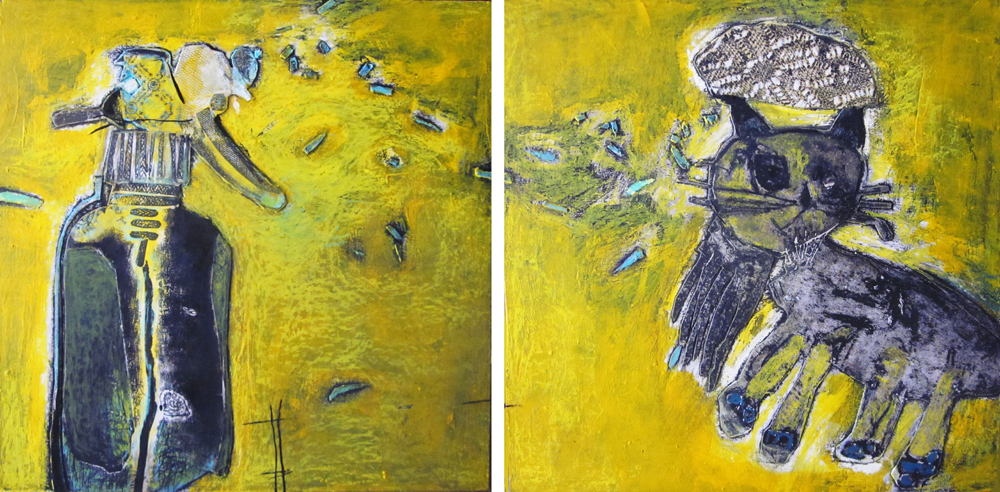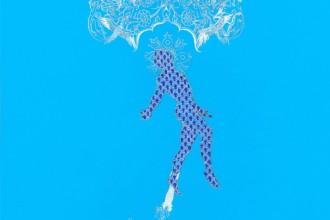
Pin the tail, or kill the cat (diptych), by Rabeya Jalil. Image courtesy ArtChowk Gallery
By Michal Hvorecký
Translated from Slovak by Eva Hudecová and Mark Lencho
Click here to read the original in Slovak
Summary
‘Danube in America’ tells a non-linear story, with the events on a river cruise triggering reflections on the history, culture, and personal experiences of an intellectual coming of age in post-communist Eastern Europe. The novel’s protagonist, the Slovak literary translator Martin Roy, is unable to make a respectable living translating classic works of Italian literature. He supplements his income by working a cruise ship as tour coordinator for an American firm at the forefront of the global cruise ship industry. With his hands already full catering to a group of helpless and self-important American retirees who are working their way down the Danube River and across central Europe, Martin is surprised by an old love interest and childhood sweetheart, Mona Mannova, who steals herself on board in rather desperate shape, with nothing but a suitcase that seems empty and a desire to rekindle a relationship with her former friend. There is something both bold and shady about the new Mona. When Martin, in a fit of pique, throws her suitcase overboard, it springs open and a stash of money seems to flutter away and disappear into the Danube.
As the story develops, Martin’s tenuous control over the ship, jeopardized further by new distractions from Mona, is completely overthrown when one of the ship’s young service women is found dead with multiple stab wounds. Plot complications hinge on whether the crew should investigate or cover up the crime. Caught in the middle, Martin tries to maintain a semblance of order, but when the killer turns his attention to Mona, Martin launches a desperate attempt to save her, before becoming hunted in his own right. The devastation turns general when the cruise ship is set on fire and is threatened with sinking. Martin survives, but it remains unclear how Mona is implicated…
When Martin woke up three hours later, America had already passed the garishly picturesque villages of upper-Austria and the lock chambers of Aschach and Ottensheim. The landing maneuver at Linz (mile 1326) had just started. Still sleepy, he looked out of the window and saw a deckhand throw a rope above his head. The captain turned the electronic steering wheel one more time. The ship approached the dock, gently bumped against its metal side and was secured to a pontoon. The main motors were turned off, and only the auxiliary system, which ran the air conditioning, the electricity, and the water circulation, remained on.
The shapeless sky’s color was reminiscent of a piece of paper covered with a black layer of soot. The water surface reflected the multi-colored lights of Lentos, a gallery of modern art. The museum’s night time light show was impressive. Black ducks with their heads thrust under their wings sat on the water not too far away.
Martin didn’t sit by Mona at breakfast because he didn’t want to attract attention. The restaurant was busy with the cacophony of clinking dishes, the sound of espresso machines and conversations. Breakfast consisted of similar offerings as the day before, supplemented by the specialty of the day. The water kettle softly and melodically whistled and sighed. Ashley was going on interminably about her six granddaughters, who lived in six different places. He nodded whenever he could and quickly ate his cornflakes with milk.
“You don’t say! Really! Excellent!†he babbled. “What a story! You must have a wonderful family. Thank you for sharing your experiences with me.â€
He hoped the woman wouldn’t test him about anything specific she had said, because he had no idea what she had been talking about. Before 9 a.m. he stood outside and greeted the passengers. The tourists didn’t need buses in the small town of Linz; they could move around on foot.
“Welcome to Austria, dear friends. As you can see, our trip is continuing in a promising fashion. By the way, this is Austria, not Australia! Don’t forget to sample the famous Linzer torte, the only dessert in the world that has an operetta composed about it. More walking awaits us today, but believe me, you won’t regret it. You will get to take the tram, too, so that you can try the town’s public transportation. We will divide into groups again. Your tour guides are looking forward to meeting you.â€
“Hi, Arthur! Hello John. Good morning, sir!†she called out. “I wish you a pleasant day! Well, sir, I have to admit that you look wonderful today!â€
“Your friend is fantastic, Martin. You should give her a job!†said John Stansky. “She’s a true talent,†Jeffrey Rose chimed in. “And she dances incredibly well!â€
“It’s too soon to judge, but it seems that she’s talented. But I don’t make the decisions; I just try to be an example to her and help her. She still has to learn a lot. The company has experts. Highly experienced professionals make these kinds of selections,†said Martin, dodging any decision-making.
“Mona, if you’d like a recommendation, let me know, I will write to Chicago!†Jeffrey suggested.
“Thank you, you’re charming!†she flattered him.
Martin couldn’t believe his own ears. Mona had all the men on the ship wrapped around her fingers. He would be happier if the tourists were complimenting him, but he conceded that so far they didn’t have anything to compliment him on – he had never before slacked off at work this much. He was worried that if Mona stayed on board longer, she would literally steal his tourists.
The group spread out and continued to the bridge, where it turned left. Peddlers mixed with the Americans, illegally hawking souvenirs, maps of the town, and overpriced brochures with panoramic photos. Usually they were successful in selling a few things. The Literary House of Adalbert Stifter stood across the street. The poster with the monthly program reminded Martin of his former career. How many books could he have translated during the time he spent on ships? What new authors could he have introduced? What new stories could he have conveyed? He had spent the past few months secretly translating at night in his cabin. But then Mona came, and he couldn’t get around to Calvino’s book.
He heard the tour guide’s narrative in his headphones. He was supposed to be keeping tabs on her to make sure that she wasn’t forgetting anything important. The woman was complaining about modern architecture and contemporary art. Most of the Americans agreed with her. Martin clenched his teeth but didn’t say anything; he wasn’t allowed to. The Austrian tour guides must have been schooled in hatred. Whether it was Thomas Bernhard, Erwin Wurm, or Franz West, they all got offensively criticized.[1]
The Celts had called Linz “Lentia,†which meant a bend in the river, but it also was the name of linden trees. He could see buildings from the Romanesque and Gothic times, but most were from the Baroque era. He would really like to go see the current exhibition at the Ars Electronica Center on the other side of the Danube, but he didn’t have enough time. The group continued down the Landstrasse, and from the looks of the locals it was obvious that they didn’t like seeing the Americans, but still they needed money. After an hour’s walk, Martin stood at the head of the group and, along with the tour guides, passed out copies of the recipe for a Linzer torte which he had downloaded from the web. These kinds of details earned him extra points, even though he knew that most of them were going to immediately lose the piece of paper, or else they were going to forget about it. He didn’t even know whether it was really possible to bake a torte out of almonds, jam, cinnamon, cloves, nutmeg, butter, eggs and salt.
“In the Linzer torte you will find everything that the Baroque cuisine considered tasty and valuable. It is only the right proportion of the ingredients that transforms them into a successful result. Ladies, don’t hesitate to take this souvenir from Linz with you to America. You don’t have to worry about the expiration date. Experts say that the longer the torte sits around, the better it becomes!â€
The group went to see an exhibition of Danube photography in the Ursuline courtyard, where they also saw a short documentary about the town’s history. Martin stayed outside and took care of some phone calls. He always made sure to be one day ahead during the cruise. While the ship was still anchored in Regensburg, he was finalizing the program in Passau; in Linz, he was taking care of Vienna, etc. When he was done, he looked over towards the Niebelung Bridge and the 1600-foot high Poestlingberg hill. This hill could be toured via the steepest rail-route in Europe. He bought a group ticket, and when he looked at the Danube, he was reminded of Karl May, who spent some time in Linz in 1902.[2] The writer lived in the hotel Chez Red Lobster, where he got into a fight with the photographer Adolf Nunwarz. The portrait photographer threw 101 negative prints of Karl May into the Danube, just like Martin had done with Mona’s money.




